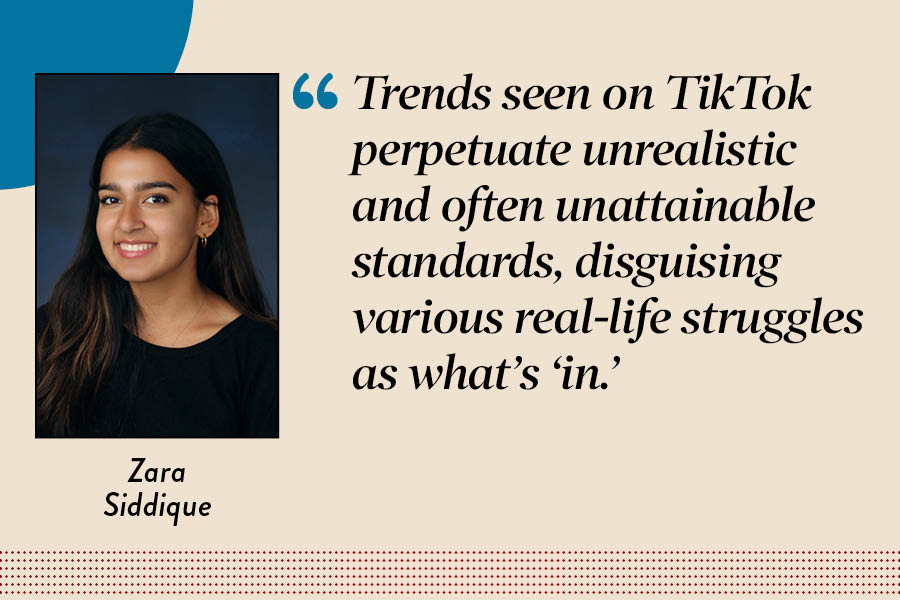TikTok promotes unhealthy trends
Midway Staff
Audience Engagement Manager Zara Siddique argues that many TikTok trends use various forms of editing to create unrealistic, harmful norms and standards.
February 16, 2023
A user opens their phone and starts scrolling through the TikTok app. A montage of an influencer’s day flashes, displaying what they eat in a day. It’s alarmingly little food, yet the user still favorites the video.
Every day over 1 billion users log on to social media app sensation TikTok, and from there they engage in the perfectly curated rabbit hole that is their For You Page, a page which uses the data the app has collected to display videos that the user has shown previous interest in. Thus came the phrase: “Which side of TikTok are you on?” meaning users with similar interests would see similar or the same videos.
Slowly, trends spread throughout these groups. First they were harmless: video games, books and food recipes. But now it seems as though there is an ulterior motive. Various trends such as “the hype,” “clean girl aesthetic,” “easy weight loss” and even the romanticization of various disorders have started frequenting viewers For You Page.
These trends seen on TikTok perpetuate unrealistic and often unattainable standards, disguising various real-life struggles as what’s “in.”
The hype, usually assigned to a famous influencer or celebrity, deems the person the new standard. The effect is brainwashing. Currently “the hype” has been assigned to 22-year-old beauty influencer Alix Earle. Ms. Earle creates three-minute “get ready with me videos,” often promoting a very unhealthy lifestyle. She frequently skips meals, opting to order fast food late at night, and drinks heavily. Despite this, many people have coined the phrase “What Would Alix Do,” in admiration of her various behaviors, thus promoting this lifestyle.
Similar to Ms. Earle’s lifestyle trends, the “clean girl aesthetic” has gained popularity, but this aesthetic is geared toward white people and a white standard of beauty. While deeming this aesthetic to be a standard of cleanliness and organization, it simultaneously deems people of color as “dirty.”
As various beauty standards on TikTok are generally directed toward women, the app also contains an intense workout and gym presence, geared towards men and promoting similar toxic standards. As most videos on TikTok are only 15 seconds, viewers are getting extremely short introductions to workouts, and harmful habits are created. Misinformation on bulking and cutting, meaning eating excessively or not at all so as to effectively gain muscle, is circulating throughout the app. With inaccurate information these seemingly helpful tips have the potential to put a viewer’s health at risk.
Misinformation is a common theme among these 15-second videos, especially pertaining to mental health and disorders. Many struggles have been generalized and deemed common and relatable. While seeing oneself in certain struggles is normal and even healthy to recognize, TikTok has taken this a couple steps too far. People have started using “OCD” to describe feelings of discomfort, and “depression” as momentary feelings of sadness. The simplification of these struggles takes away from their seriousness.
As TikTok continues to increase in popularity, it is crucial that users stay aware of the impending threats the app promotes with a constant rotation of trends, all with underlying themes. The standards that are promoted are, more often than not, upholding white and societal standards that are ultimately unattainable.




























































